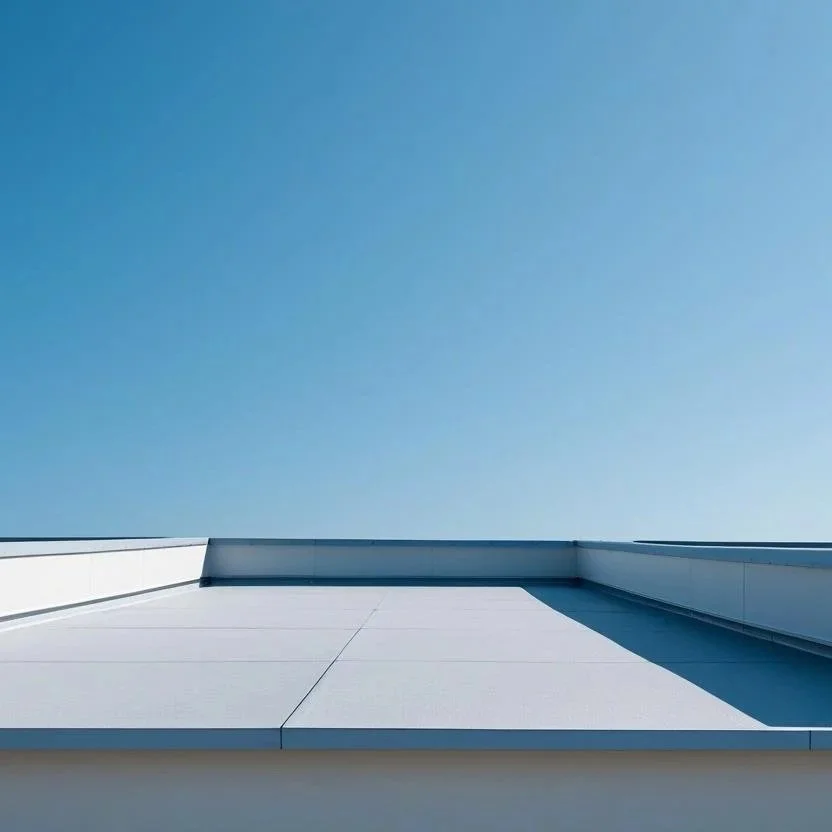Flat Roof Fiascos Fixed with Sealant Solutions
Sealant solutions stop that erosion cold, but only when handled by professionals who know their coatings from their catastrophes.
Flat roofs have a poker face for about five minutes. After that, they show every mood swing. One moment, they seem fine. Next, water decides to pool, seams start lifting, and that strange bubbling near the HVAC unit refuses to mind its business. When roofs behave like this, they're not looking for a pep talk. They need professional flat roof sealing and repair before leaks spiral into chaos.
The problem with flat roofs isn't that they're actually flat. They have a slight slope. It's just not enough to send water racing off like on a pitched roof. So moisture lingers. Over time, that lingering water becomes a hobbyist in erosion. Sealant solutions stop that erosion cold, but only when handled by professionals who know their coatings from their catastrophes.
Leaks Don't Knock First
Leaks don't ask permission. They sneak in through failed seams, flashing gaps, punctures, and worn-out membranes. Sometimes they arrive solo. Other times, they invite the entire extended family of rot, mold, and insulation damage. Many owners don't even notice until the ceiling tiles stain or the office printer room smells like a swamp.
Water doesn't just drip straight down. It wanders. It travels along beams and materials, soaking everything in its path. By the time the first stain appears, the water may have already wrecked half the underlayers. Sealing stops water in its tracks before it moves in for good.
Sealing Is Like Giving the Roof a New Lease on Life
Flat roof sealing and repair is the superhero cape a roof doesn't know it needs. Professional sealing coats the surface with a protective barrier that resists moisture, reflects UV rays, and closes off minor imperfections before they grow fangs. A properly sealed roof acts younger, tougher, and more reliable, even after years of sun exposure and seasonal abuse.
The right sealant depends on the roof type. Modified bitumen systems require a different material than EPDM rubber, and TPO has its preferences. Professionals match the sealant formula to the material, making sure the chemistry bonds instead of flakes. When applied with the right prep and weather conditions, the sealant creates a smooth, durable layer across the entire field.
Preparation Is Not Optional
Applying sealant to a dirty, damp, or damaged surface is akin to painting a cracked wall without first sanding it. It might look better temporarily, but trouble lurks underneath. Professional crews prep the roof by cleaning debris, checking for trapped moisture, repairing splits, and drying the surface thoroughly before any product is applied.
It's tempting to rush through prep, but that's how failures happen. Professionals take their time. They walk the surface, press the seams, and run diagnostics to make sure the roof is a good candidate for sealing. No decent contractor ever says, "That's probably fine" before putting down liquid barrier protection.
Commercial Roofs Love a Little TLC
Commercial buildings often cover a lot of real estate with their roofs. When something goes wrong, it multiplies quickly. Offices, warehouses, retail centers, and medical buildings all rely on dry interiors, functional HVAC units, and energy efficiency. A failing flat roof throws a wrench in every single one of those priorities.
Sealing becomes more than a leak-stopper. It helps reduce building heat load by reflecting sunlight, preserves the structural integrity of the roof deck, and prevents surprise emergencies that scare tenants and building managers alike. A sealed commercial roof has better curb appeal and fewer angry maintenance calls.
Time Isn't Always Kind to Membranes
Flat roof membranes start life flexible and strong. Over time, factors such as sun exposure, foot traffic, temperature swings, and environmental wear turn them brittle. Seams lift. Edges curl. Cracks open. The changes happen gradually until one rainy season turns subtle wear into significant damage.
Sealing helps extend the useful life of the membrane before full replacement becomes unavoidable. With the right timing, property owners save thousands by investing in sealing and small repairs instead of a total rip-and-replace. Professionals identify the right window before damage becomes irreversible.
Not All Sealants Are Created Equal
Just because a bucket says "roof sealant" doesn't mean it's fit for every job. Some sealants are elastomeric. Others are silicone-based. Some need to be rolled on. Others are sprayed. The choice depends on the roof's material, age, slope, and location. Sun-heavy regions need reflective options. Cold climates demand flexibility. A poorly matched sealant might peel or crack within a year.
Professionals understand product performance over time. They know which brands hold up through storms, which require specific primers, and how thick each layer needs to be for full protection. It's not just chemistry—it's experience, intuition, and rooftop savvy earned the hard way.
Seasonal Strategy Keeps Sealing Successful
Flat roof sealing doesn't play well with bad weather. Rain ruins everything. Cold temperatures mess with curing time. High humidity creates a sticky mess. That's why roofing professionals choose their seasons carefully. Spring and fall tend to be sealing favorites for their mild conditions and predictable forecasts.
Professional crews schedule around weather patterns. They monitor the forecast days in advance, start early in the morning, and give sealants time to set before clouds start thinking about raining. Timing matters. So does surface temperature. So does wind speed. The success of sealing often depends on a 24-hour window handled by people who know how to read the sky as well as the membrane.
Even Small Leaks Deserve Big Attention
There's no such thing as a harmless drip. A tiny leak might seem manageable, but flat roofs are layered like a sandwich. Once water slips between layers, it's almost impossible to track without damaging the top surface. Moisture in the insulation lowers R-value. Moisture near electrical conduits creates safety hazards. Moisture under walkways compromises weight-bearing capacity.
Sealing shuts down small leaks before they do expensive damage. It also creates a uniform surface, making future maintenance easier. Professionals often say they can tell a roof's story just by walking on it. Sealing gives that story a happy ending instead of a tragic plot twist.
Foot Traffic and Rooftop Work Create Trouble Spots
Many commercial flat roofs double as highways for maintenance crews. HVAC technicians walk to their units. Solar installers climb around panels. Antenna techs drag cables across the surface. All that activity creates tiny abrasions that break down the top membrane.
Professional sealing includes reinforcement around high-traffic zones. Some areas receive multiple coats or added mesh for strength. Walk pads or designated pathways help manage future wear and prevent future problems. A sealed roof doesn't mean a neglected roof. It needs some boundaries and care.
Sealing Saves Budgets and Tempers
No one enjoys surprise roof expenses. Unplanned water damage means interior repairs, furniture replacement, insurance headaches, and angry conversations with tenants. Sealing provides a budget-friendly middle ground that prevents emergencies while keeping replacement plans on the long-term calendar.
Compared to full tear-off and reinstallation, sealing is quiet, fast, and low-impact. Business can continue inside the building while sealing work happens above. There's no demolition, no dumpsters, and no six-week disruption. Property managers keep their routines. Building owners keep their margins. Tenants stay dry and undisturbed.
Professional Crews Leave Nothing to Chance
The difference between a well-sealed roof and one that fails within a year often comes down to the crew. Professionals know how to stage materials, follow manufacturer specifications, apply even layers, and troubleshoot the weird spots that throw off less experienced hands.
Drains, corners, and transitions between different roof systems require finesse. Nozzle angles matter. Cure times matter. Even how the crew moves across the surface can affect the final results. Professional teams treat every sealing job as part art, part science, and part strategy.
Maintenance Keeps the Seal Strong
Sealing a roof doesn't mean ignoring it until the next decade. Scheduled maintenance keeps sealed surfaces in top shape. Professional follow-up visits catch minor wear early. Small touch-ups reinforce problem areas before they return. Seasonal inspections after storms or freeze-thaw cycles help track performance.
Professionals also document the sealing project. Photos, material specs, warranty info, and project notes provide a record of care that helps with future budgeting and resale value. A well-sealed roof backed by professional service gives owners long-term confidence without the drama of surprise leaks.
Flat Roof Sealing and Repair Is the Calm After the Storm
When done right, flat roof sealing is a stress reliever. Owners sleep better. Tenants stop submitting wet ceiling complaints. The building starts aging gracefully again. It's not magic. It's just the result of skilled people doing the right work with the right materials at the right time.
Sealant solutions turn flat roof fiascos into quiet, dependable rooftops that stay dry, solid, and ready for the next season. No fuss. No leaks. Just professional care on a surface that finally behaves.

